Thermal Structure of the Northern Outer Albanides and Adjacent Adriatic Crustal Sector, and Implications for Geothermal Energy Systems
Abstract
:1. Introduction
2. Geological Background
Active Tectonics
3. Materials and Methods
3.1. Balanced and Restored Geological Cross-Section
3.2. Analytical Procedure for Thermal Modeling
4. Results
4.1. Balanced Cross-Section
4.2. Thermal Modeling
5. Potential Exploitation of the Geothermal Energy
6. Conclusions
Author Contributions
Funding
Acknowledgments
Conflicts of Interest
References
- Jaupart, C.; Mareschal, J.C. The thermal structure and thickness of continental roots. Lithos 1999, 48, 93–114. [Google Scholar] [CrossRef]
- Cheng, L.Z.; Mareschal, J.C.; Jaupart, C.; Rolandone, F.; Gariépy, C.; Radigon, M. Simultaneous inversion of gravity and heat flow data: Constraints on thermal regime, rheology and evolution of the Canadian Shield crust. J. Geodyn. 2002, 34, 11–30. [Google Scholar] [CrossRef]
- McKenzie, D.; Jackson, J.; Priestley, K. Thermal structure of oceanic and continental lithosphere. Earth Planet. Sci. Lett. 2005, 233, 337–349. [Google Scholar] [CrossRef]
- Chen, W. Rheology of the continental lithosphere: Progress and new perspectives. Gondwana Res. 2012, 21, 4–18. [Google Scholar] [CrossRef]
- Cermak, V.; Kresel, M.; Kucerovà, L.; Safanda, J.; Frasheri, A.; Kapedani, N.; Lico, R.; Cano, D. Heat Flow in Albania. Geothermics 1996, 25, 91–102. [Google Scholar] [CrossRef]
- Frasheri, A.; Bushati, S.; Bare, V. Geophysical outlook on structure of the Albanides. J. Balkan Geophys. Soc. 2009, 12, 9–30. [Google Scholar]
- Philipp, S.L.; Gudmundsson, A.; Oelrich, A.R.I. How structural geology can contribute to make geothermal projects successful. In Proceedings of the European Geothermal Congress, Unterhaching, Germany, 30 May–1 June 2007. [Google Scholar]
- Moeck, I.S. Catalog of geothermal play types based on geologic controls. Renew. Sustain. Energy Rev. 2014, 37, 867–882. [Google Scholar] [CrossRef] [Green Version]
- Velaj, T. The structural style and hydrocarbon exploration of the subthrust in the Berati Anticlinal Belt, Albania. J. Pet. Explor. Prod. Technol. 2015, 5, 123–145. [Google Scholar] [CrossRef] [Green Version]
- Roure, F.; Nazaj, S.; Mushka, K.; Fili, I.; Cadet, J.P.; Bonneau, M. Kinematic evolution and petroleum systems—An appraisal of the Outer Albanides. In Thrust Tectonics and Hydrocarbon Systems; McClay, K.R., Ed.; AAPG Mem: Tulsa, OK, USA, 2004; Volume 82, pp. 474–493. [Google Scholar]
- Muceku, B.; Mascle, G.; Tashko, A. First results of fission-track thermochronology in the Albanides. In Tectonic Development of the Eastern Mediterranean Region; Robertson, A.H.F., Mountrakis, D., Eds.; Special Publications; Geological Society: London, UK, 2006; Volume 260, pp. 539–556. [Google Scholar] [CrossRef]
- Muceku, B.; van der Beek, P.; Bernet, B.; Reiners, P.; Mascle, G.; Tashko, A. Thermochronological evidence for Mio-Pliocene late orogenic extension in the north-eastern Albanides (Albania). Terra Nova 2008, 20, 180–187. [Google Scholar] [CrossRef] [Green Version]
- Frasheri, A.; Nishani, P.; Bushati, S.; Hyseni, A. Geophysical Study of the Albanides. Bolletino Geofis. Teor. Appl. 1995, 37, 83–108. [Google Scholar]
- Robertson, A.H.F.; Shallo, M. Mesozoic-Tertiary tectonic evolution of Albania in its regional Eastern Mediterranean context. Tectonophysics 2000, 316, 197–254. [Google Scholar] [CrossRef]
- Mazzoli, S.; Santini, S.; Macchiavelli, C.; Ascione, A. Active tectonics of the outer northern Appennines: Adriatic vs. Po Plain seismicity and stress fields. J. Geodyn. 2015, 84, 62–76. [Google Scholar] [CrossRef]
- Frasheri, A.; Nishani, P.; Bushati, S.; Hyseni, A. Relationship between tectonic zone of the Albanides, based on results of geophysical studies. In PeriTethys Memoir 2: Structure and Prospects of Alpine Basins and Forelands; Ziegler, P., Horvath, F., Eds.; Mémoires du Muséum National d’Histoire Naturelle: Paris, France, 1996; Volume 170, pp. 485–511. [Google Scholar]
- Roure, F.; Sassi, W. Kinematics of deformation and petroleum system appraisal in Neogene foreland fold-and-thrust belts. Pet. Geosci. 1995, 1, 253–269. [Google Scholar] [CrossRef]
- Velaj, T. Evaporites in Albania and their impact on the thrusting processes. J. Balkan Geophys. Soc. 2001, 4, 9–18. [Google Scholar] [CrossRef] [Green Version]
- Zappaterra, E. Carbonate paleogeographic sequences of the Periadriatic region. Boll. Soc. Geol. Ital. 1990, 109, 5–20. [Google Scholar]
- Mecaj, B.; Mahmutaj, L. The main lithologo-petrographic characteristics of carbonate and terrigenous deposits in the south-western external Albanides. In Proceedings of the ALBPETROL-95 Symposium, Fier, Albania, 23–26 November 1995. [Google Scholar]
- Bega, Z.; Soto, J.I. The ionian fold-and-thrust belt in Central and Southern Albania: A petroleum province with triassic evaporites. In Permo-Triassic Salt Provinces of Europe, North Africa and the Atlantic Margins; Elsevier: Amsterdam, The Netherlands, 2017; pp. 517–539. [Google Scholar] [CrossRef]
- Grünthal, G.; Wahlström, R. The European-Mediterranean Earthquake Catalogue (EMEC) for the last millennium. J. Seismol. 2012, 16, 535–570. [Google Scholar] [CrossRef] [Green Version]
- Stucchi, M.; Rovida, A.; Gomez Capera, A.A.; Alexandre, P.; Camelbeeck, T.; Demircioglu, M.B.; Gasperini, P.; Kouskouna, V.; Musson, R.M.; Radulian, M.; et al. The SHARE European Earthquake Catalogue (SHEEC) 1000-1899. J. Seismol. 2013, 17, 523–544. [Google Scholar] [CrossRef] [Green Version]
- DISS Working Group. Database of Individual Seismogenic Sources (DISS), Version 3.2.1: A Compilation of Potential Sources for Earthquakes Larger than M 5.5 in Italy and Surrounding Areas; Istituto Nazionale di Geofisica e Vulcanologia: Sezione di Napoli, Italy, 2018. [Google Scholar] [CrossRef]
- European Mediterranean RCMT Catalog. Available online: http://rcmt2.bo.ingv.it/ (accessed on 8 August 2020).
- Istituto Nazionale di Geofisica e Vulcanologia. Available online: http://terremoti.ingv.it/iside (accessed on 8 August 2020).
- Federal Office of Topography Swisstopo Geodesy Permanent Network Information Service. Available online: http://pnac.swisstopo.admin.ch/divers/dens_vel/combvel_se_all_cmb_grd_east.jpg (accessed on 8 August 2020).
- Caporali, A.; Floris, M.; Chen, X.; Nurçe, B.; Bertocco, M.; Zurutuza, J. The November 2019 Seismic Sequence in Albania: Geodetic Constraints and Fault Interaction. Remote Sens. 2020, 12, 846. [Google Scholar] [CrossRef] [Green Version]
- Pondrelli, S. European-Mediterranean Regional Centroid-Moment Tensors Catalog (RCMT) [Data Set]; Istituto Nazionale di Geofisica e Vulcanologia: Sezione di Napoli, Italy, 2002. [Google Scholar] [CrossRef]
- The SHARE European Earthquake Catalogue (SHEEC) 1000-1899. Available online: https://www.emidius.eu/SHEEC/sheec_1000_1899.html (accessed on 2 September 2020).
- GFZ Helmholtz Centre POTSDAM. Available online: https://www.gfz-potsdam.de/en/section/seismic-hazard-and-risk-dynamics/data-products-services/emec-earthquake-catalogue/ (accessed on 2 September 2020).
- SARVIEWS. Available online: https://sarviews-hazards.alaska.edu/ (accessed on 30 June 2020).
- European Environment Agency. Available online: https://www.eea.europa.eu/ (accessed on 2 September 2020).
- Grad, M.; Tiire, T.; ESC Working Group. The Moho depth map of the European Plate. Geophys. J. Int. 2009, 176, 279–292. [Google Scholar] [CrossRef] [Green Version]
- Molnar, P.; Chen, W.P.; Padovani, E. Calculated temperatures in overthrust terrains and possible combinations of heat sources responsible for the tertiary granites in the greater Himalaya. J. Geophys. Res. 1983, 88, 6415–6429. [Google Scholar] [CrossRef]
- Candela, S.; Mazzoli, S.; Megna, A.; Santini, S. Finite element modelling of stress field perturbations and interseismic crustal deformation in the Val d’Agri region, southern Apennines, Italy. Tectonophysics 2015, 657, 245–259. [Google Scholar] [CrossRef]
- Sibson, R.H. Frictional constraints on thrust, wrench and normal faults. Nature 1974, 249, 542–544. [Google Scholar] [CrossRef]
- Byerlee, J.D. Frictional characteristics of granite under high confining pressure. J. Geophys. Res. 1967, 72, 3639–3648. [Google Scholar] [CrossRef]
- Byerlee, J.D. Friction of rocks. Pure Appl. Geophys. 1978, 116, 615. [Google Scholar] [CrossRef]
- Cermak, V. Lithospheric Thermal Regimes in Europe. Phys. Earth Planet. Inter. 1993, 79, 179–193. [Google Scholar] [CrossRef]
- Dragoni, M.; Doglioni, C.; Mongelli, F.; Zito, G. Evaluation of stresses in two geodynamically different areas: Stable foreland and extensional backarc. Pure Appl. Geophys. 1996, 146, 319–341. [Google Scholar] [CrossRef]
- Frasheri, A.; Frasheri, N. Geothermal Energy Resources in Albania–Country Update. In Proceedings of the World Geothermal Congress, Antalya, Turkey, 24–29 April 2005. [Google Scholar]
- Nieuwland, D.A.; Oudmayer, B.C.; Valbona, U. The tectonic development of Albania: Explanation and prediction of structural styles. Mar. Pet. Geol. 2001, 18, 161–177. [Google Scholar] [CrossRef]
- Lacombe, O.; Malandain, J.; Vilasi, N.; Amrouch, K.; Roure, F. From paleostresses to paleoburial in fold-thrust belts: Preliminary results from calcite twin analysis in the Outer Albanides. Tectonophysics 2009, 475, 128–141. [Google Scholar] [CrossRef]
- Szaniawski, R.; Mazzoli, S.; Jankowski, L. Controls of structural inheritance on orogenic curvature and foreland basin sedimentation: Insights from the Przemyśl area, Western Carpathians. J. Struct. Geol. 2017, 103, 137–150. [Google Scholar] [CrossRef]
- Megna, A.; Candela, S.; Mazzoli, S.; Santini, S. An Analytical model for the geotherm in the Basilicata oil fields area (southern Italy). Ital. J. Geosci. 2014, 133, 204–213. [Google Scholar] [CrossRef]
- Basilici, M.; Mazzoli, S.; Megna, A.; Santini, S.; Tavani, S. Geothermal Model of the Shallow Crustal Structure across the “Mountain Front Fault” in Western Lurestan, Zagros Thrust Belt, Iran. Geosciences 2019, 9, 301. [Google Scholar] [CrossRef] [Green Version]
- Basilici, M.; Mazzoli, S.; Megna, A.; Santini, S.; Tavavi, S. 3-D Geothermal Model of the Lurestan Sector of the Zagros Thrust Belt, Iran. Energies 2020, 13, 2140. [Google Scholar] [CrossRef]
- Frasheri, A. Geothermal Energy Resources in Albania-Country Update Paper. In Proceedings of the World Geothermal Congress, Bali, Indonesia, 25–29 April 2010. [Google Scholar]
- Fitz-Diaz, E.; Hudleston, P.; Siebenaller, L.; Kirschner, D.; Camprubì, A.; Tolson, G.; Pi Puig, T. Insights into fluid flow and water-rock interaction during deformation of carbonate sequences in the Mexican fold-thrust belt. J. Struct. Geol. 2011, 33, 1237–1253. [Google Scholar] [CrossRef]
- Evans, M.A.; Fischer, M.P. On the distribution of fluids in folds: A review of controlling factors and processes. J. Struct. Geol. 2012, 44, 2–24. [Google Scholar] [CrossRef]
- Gabellone, T.; Gasparrini, M.; Iannace, A.; Invernizzi, C.; Mazzoli, S.; D’Antonio, M. Fluid channeling along thrust zones: The Lagonegro case history, southern Appennines, Italy. Geofluids 2013, 13, 140–158. [Google Scholar] [CrossRef] [Green Version]
- Lacroix, B.; Travé, A.; Bautier, M.; Labaume, P.; Vennemann, T.; Dubois, M. Syntectonic fluid-flow along thrust faults: Example of the South-Pyrenean fold-and-thrust belt. Mar. Pet. Geol. 2014, 49, 84–98. [Google Scholar] [CrossRef]
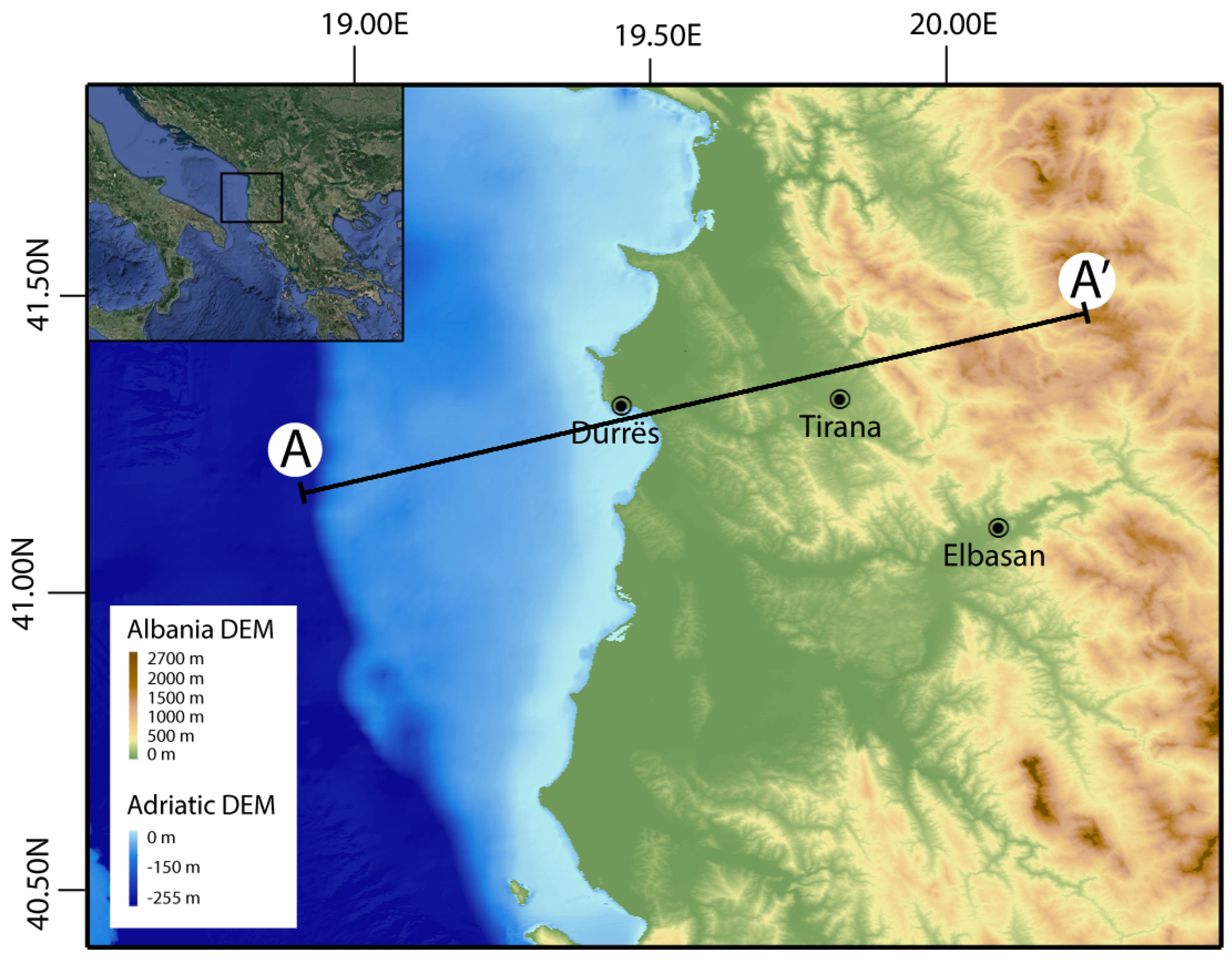
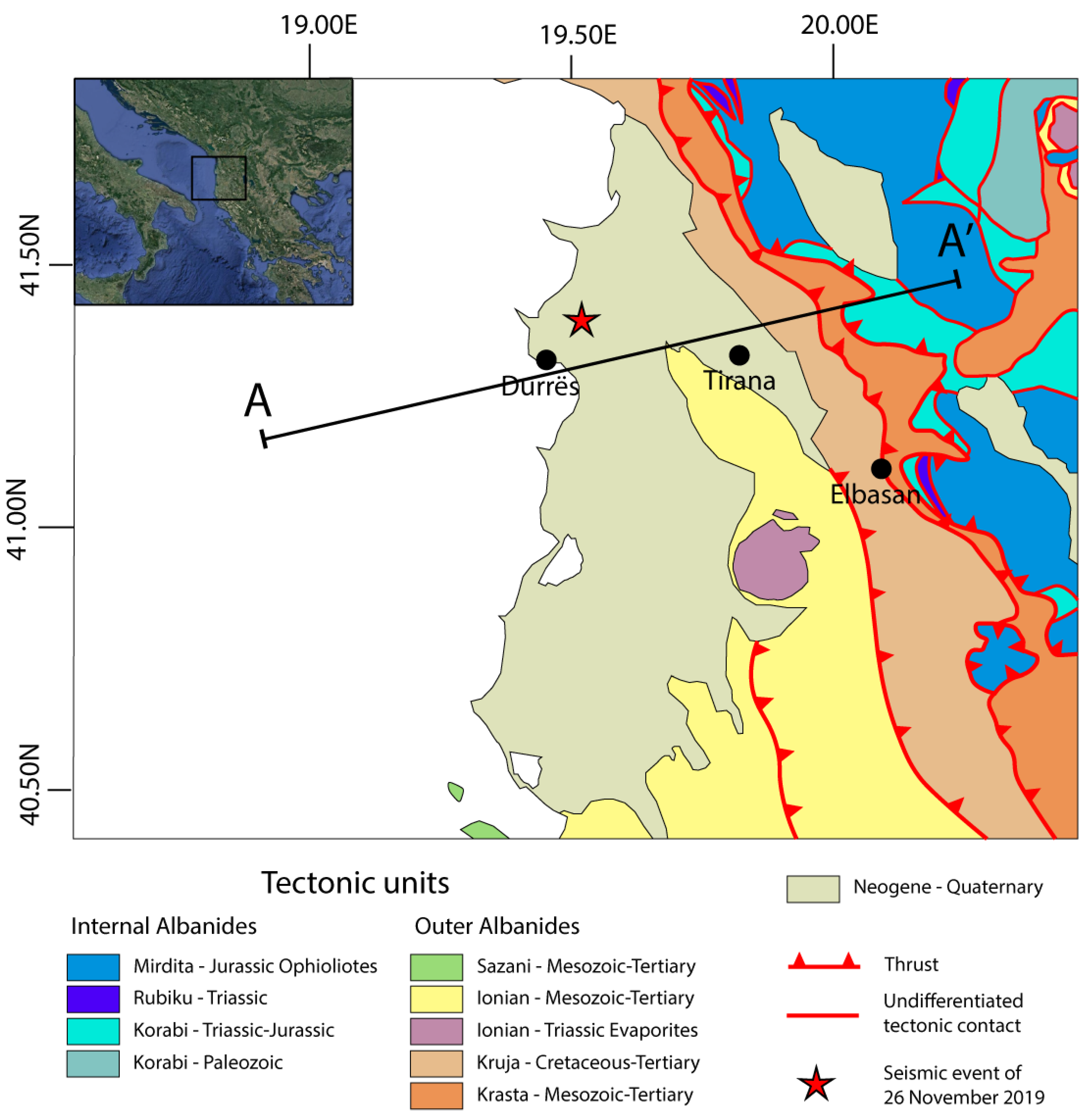

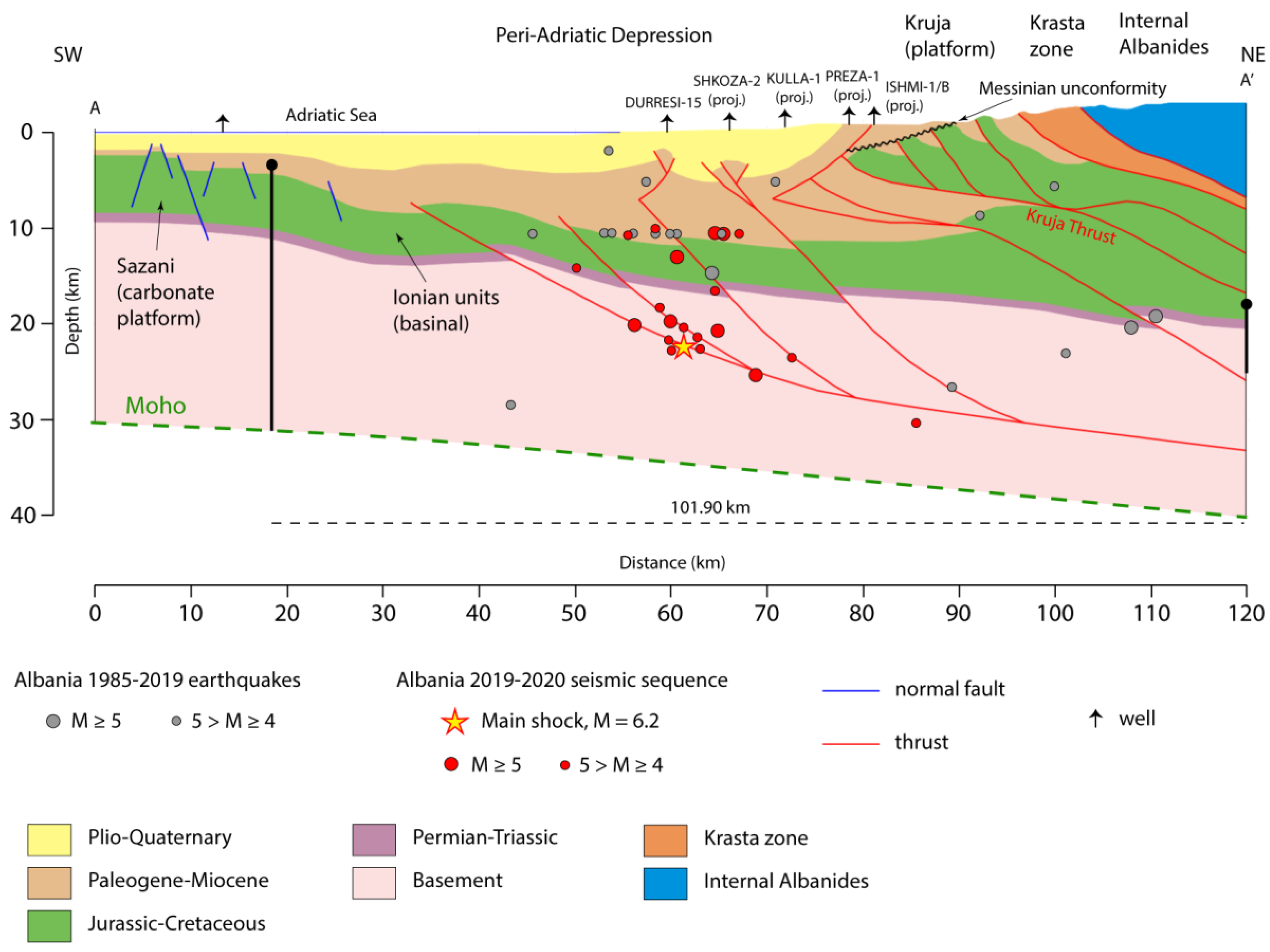

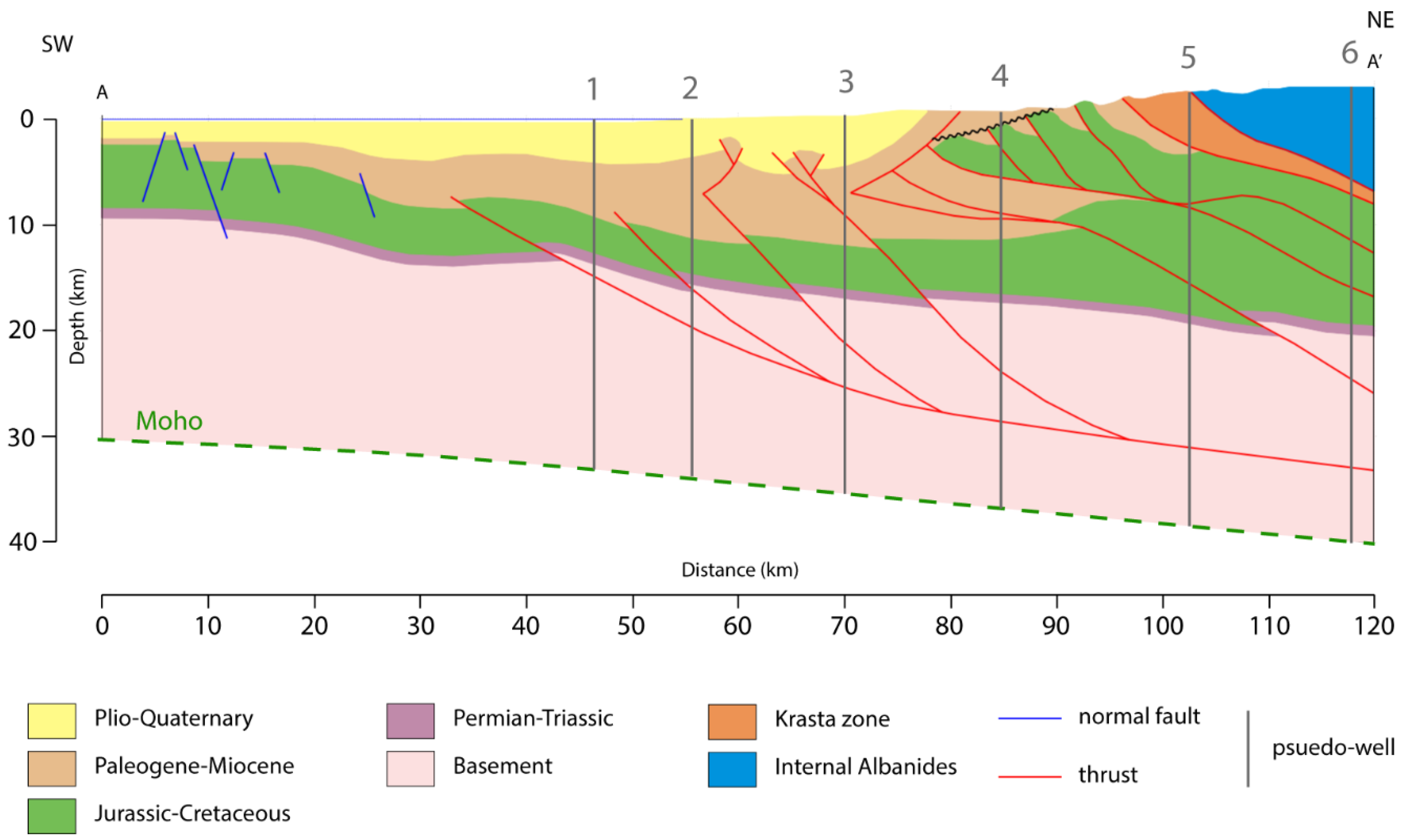


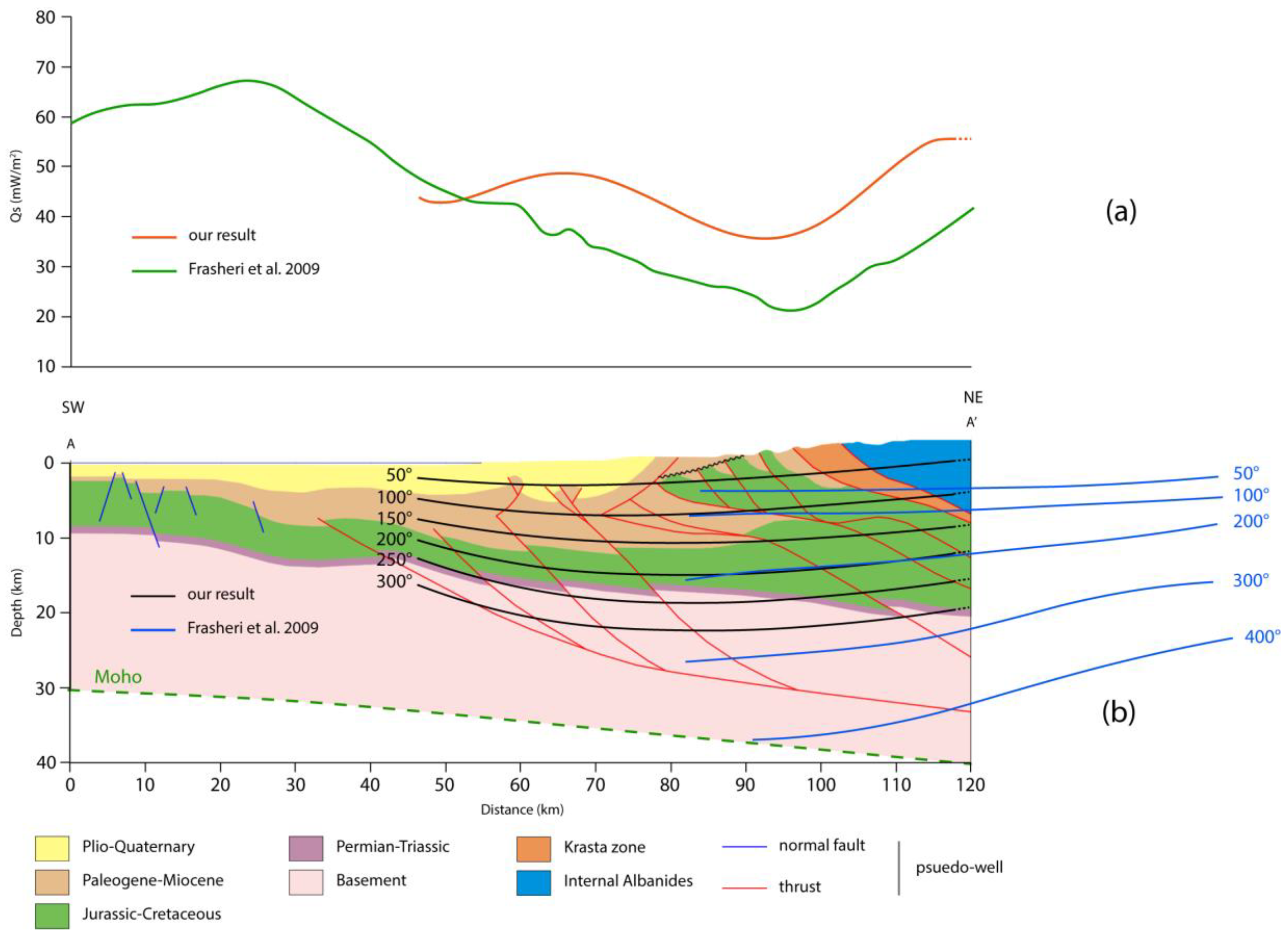


| Tf | ||||
| an | ||||
| An | ||||
| Tf | ||||
| an | ||||
| An | ||||
| Tf | ||||
| an | ||||
| An | ||||
| Tf | ||||
| an | ||||
| An | ||||
| sedimentary cover thickness | thermal diffusivity coefficient | ||
| basement thickness | thermal conductivity coefficient | ||
| whole crustal thickness | σ | shear stress | |
| sedimentary cover temperature | slip rate | ||
| mantle heat temperature | μ | friction coefficient | |
| radiogenic heat temperature | surface heat flow density | ||
| fault friction heat temperature | mantle heat flow density | ||
| surface temperature | radioactivity produced heat | ||
| final temperature | heat depth length scale |
Publisher’s Note: MDPI stays neutral with regard to jurisdictional claims in published maps and institutional affiliations. |
© 2020 by the authors. Licensee MDPI, Basel, Switzerland. This article is an open access article distributed under the terms and conditions of the Creative Commons Attribution (CC BY) license (http://creativecommons.org/licenses/by/4.0/).
Share and Cite
Santini, S.; Basilici, M.; Invernizzi, C.; Mazzoli, S.; Megna, A.; Pierantoni, P.P.; Spina, V.; Teloni, S. Thermal Structure of the Northern Outer Albanides and Adjacent Adriatic Crustal Sector, and Implications for Geothermal Energy Systems. Energies 2020, 13, 6028. https://doi.org/10.3390/en13226028
Santini S, Basilici M, Invernizzi C, Mazzoli S, Megna A, Pierantoni PP, Spina V, Teloni S. Thermal Structure of the Northern Outer Albanides and Adjacent Adriatic Crustal Sector, and Implications for Geothermal Energy Systems. Energies. 2020; 13(22):6028. https://doi.org/10.3390/en13226028
Chicago/Turabian StyleSantini, Stefano, Matteo Basilici, Chiara Invernizzi, Stefano Mazzoli, Antonella Megna, Pietro Paolo Pierantoni, Vincenzo Spina, and Simone Teloni. 2020. "Thermal Structure of the Northern Outer Albanides and Adjacent Adriatic Crustal Sector, and Implications for Geothermal Energy Systems" Energies 13, no. 22: 6028. https://doi.org/10.3390/en13226028





